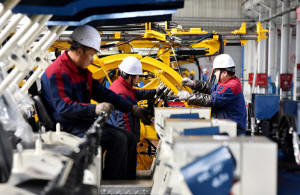China's factory output disappoints, property sector stuck in doldrums
 Send a link to a friend
Send a link to a friend
 [June 17, 2024] By
Kevin Yao, Albee Zhang and Ellen Zhang [June 17, 2024] By
Kevin Yao, Albee Zhang and Ellen Zhang
BEIJING (Reuters) -China's May industrial output lagged expectations and
a slowdown in the property sector showed no signs of easing despite
policy support, adding pressure on Beijing to shore up growth.
Apart from retail sales that beat forecasts due to a holiday boost, the
flurry of data on Monday was largely downbeat, underscoring a bumpy
recovery for the world's second-largest economy.
May industrial output grew 5.6% from a year earlier, National Bureau of
Statistics (NBS) data showed, slowing from the 6.7% pace in April and
below expectations for a 6.0% increase in a Reuters poll of analysts.
However, retail sales, a gauge of consumption, in May rose 3.7% on year,
accelerating from a 2.3% rise in April and marking the quickest growth
since February. Analysts had expected a 3.0% expansion due to a five-day
public holiday earlier in the month.
"May activity data and our high-frequency trackers for the first half of
June suggest significant cross-sector divergences remain in the economy
- strong exports and manufacturing activity, relatively stable
consumption, and still-depressed property activity," Goldman Sachs
analysts said in a note.
Fixed asset investment rose 4.0% in the first five months of 2024 from
the same period a year earlier, versus expectations for a 4.2% rise. It
grew 4.2% in the January to April period.
Manufacturing investment in the first five months showed robust growth
of 9.6%, underpinned by China's emphasis for "quality growth" through
technological breakthroughs and innovation this year.

But economists have warned that rising trade tensions with the West over
China's so-called over-capacity may impose more challenges to Chinese
solar and electric vehicle producers.
Private sector investment grew 0.1% in January-May, down from 0.3% in
the first four months, pointing to still weak confidence among private
businesses. By comparison, investment in the state sector jumped 7.1% in
the first five months.
Asian share markets were mostly softer following the mixed data with the
Chinese blue chip CSI300 index slipping 0.2%.
EXPORTS-LED RECOVERY
Exports helped bolster the economy, with steel and aluminum output
posting sharp jumps in May.
"Exports drove industrial growth and manufacturing investment
significantly, but real estate weakness still hit household consumption
and investment," said ZhaoPeng Xing, senior China strategist at ANZ.
China's property market slump, high local government debt and
deflationary pressure remain heavy drags on economic activity. The
latest figures point to an uneven growth that reinforces calls for more
fiscal and monetary policy support.
With banks facing narrowing interest margins and a weakening currency
remaining key constraints limiting Beijing's scope to ease monetary
policy, China's central bank left a key policy rate unchanged as
expected on Monday.
[to top of second column] |

Employees work on a drilling machine production line at a factory in
Zhangjiakou, Hebei province, China November 14, 2018.
REUTERS/Stringer/File Photo

"We still see the likelihood of a cut to the Loan Prime Rate (LPR)
this month, particularly on the 5-year tenor, as this will help
banks to retain households' mortgage loans," said Zhou Hao, chief
economist at Guotai Junan International.
But chief China economist at Citi Yu Xiangrong expects a total
20-basis-point policy rate reduction in the second half of this
year, but no LPR cut on June 20.
PROPERTY DATA WORSEN
China's economy grew a faster-than-expected 5.3% in the first
quarter, but analysts say the government's annual growth target of
around 5% is ambitious as the property sector remains in the
doldrums.
Property investment fell 10.1% year-on-year in January-May,
deepening from a decline of 9.8% in January-April.
New home prices slipped 0.7% in May from April, marking the 11th
straight month-on-month decline and steepest drop since October
2014, according to Reuters calculations based on NBS data.
The central bank last month announced a relending program for
affordable housing to accelerate sales of unsold housing stock.
NBS spokesperson Liu Aihua told a media briefing on Monday that the
property market is undergoing adjustment and it will take some time
for policy measures to kick in.
The property sector, which accounted for around a quarter of
economic output before the downturn, has been hit by a regulatory
crackdown as well as demographic and broad economic pressures. The
government has launched a slew of measures to help homebuyers, such
as easing mortgage rules.
But tepid demand at home has kept a lid on consumer prices as
confidence remains low in the face of a protracted property sector
crisis. New bank lending rebounded far less than expected in May and
some key money gauges hit record lows.
The job market overall was steady. The nationwide survey-based
jobless rate hit 5.0% in May, the same as that in April.

Beijing has vowed to create more jobs linked to major projects,
promote domestic demand and pledged greater fiscal stimulus to shore
up growth.
(Reporting by Albee Zhang, Ellen Zhang and Kevin Yao; Editing by
Jacqueline Wong)
[© 2024 Thomson Reuters. All rights
reserved.]
This material may not be published,
broadcast, rewritten or redistributed.
Thompson Reuters is solely responsible for this content.
 |